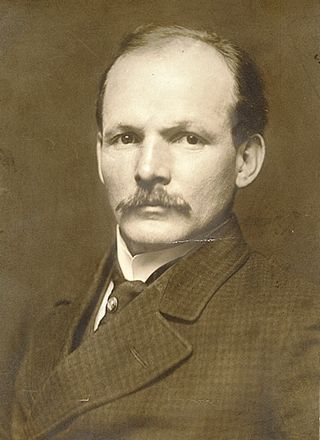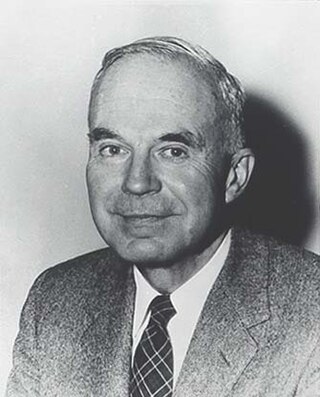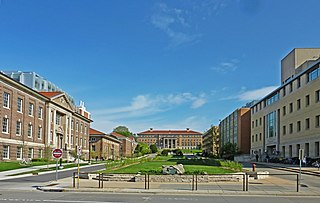
The Mount Rushmore National Memorial is a national memorial centered on a colossal sculpture carved into the granite face of Mount Rushmore in the Black Hills near Keystone, South Dakota, United States. Sculptor Gutzon Borglum designed the sculpture, called Shrine of Democracy, and oversaw the project's execution from 1927 to 1941 with the help of his son, Lincoln Borglum. The sculpture features the 60-foot-tall (18 m) heads of four United States presidents: George Washington, Thomas Jefferson, Theodore Roosevelt, and Abraham Lincoln, chosen to represent the nation's birth, growth, development, and preservation, respectively. Mount Rushmore attracts more than two million visitors annually to the memorial park which covers 1,278 acres. The mountain's elevation is 5,725 feet (1,745 m) above sea level.

William Dempster Hoard was an American politician, newspaper publisher, and agriculture advocate who served as the 16th governor of Wisconsin from 1889 to 1891.

John Gutzon de la Mothe Borglum was an American sculptor best known for his work on Mount Rushmore. He is also associated with various other public works of art across the U.S., including Stone Mountain in Georgia, statues of Union General Philip Sheridan in Washington D.C. and in Chicago, as well as a bust of Abraham Lincoln exhibited in the White House by Theodore Roosevelt and now held in the United States Capitol crypt in Washington, D.C.

Solon Hannibal de la Mothe Borglum was an American sculptor. He is most noted for his depiction of frontier life, and especially his experience with cowboys and native Americans.
Hoard's Dairyman is an American agricultural trade publication that focuses on dairy farming. It was founded in 1885 by William D. Hoard as a supplement to the Jefferson County Union and is published in Fort Atkinson, Wisconsin.

Jonah LeRoy "Doane" Robinson was an American historian who was the state historian of South Dakota. He is known for conceiving of the idea for the Mount Rushmore National Memorial in the Black Hills, which he believed would stimulate tourism to the area.

Walker Kirtland Hancock was an American sculptor and teacher. He created notable monumental sculptures, including the Pennsylvania Railroad World War II Memorial (1950–52) at 30th Street Station in Philadelphia, and the World War I Soldiers' Memorial (1936–38) in St. Louis, Missouri. He made major additions to the National Cathedral in Washington, D.C., including Christ in Majesty (1972), the bas relief over the High Altar. Works by him are presently housed at the U.S. Military Academy at West Point, the Library of Congress, the U.S. Supreme Court, and the United States Capitol.

John Sherrill Houser was an American painter and sculptor.
Roman Bronze Works, now operated as Roman Bronze Studios, is a bronze foundry in New York City. Established in 1897 by Riccardo Bertelli, it was the first American foundry to specialize in the lost-wax casting method, and was the country's pre-eminent art foundry during the American Renaissance.

The University of Wisconsin–Madison is a public land-grant research university in Madison, Wisconsin, United States. Founded when Wisconsin achieved statehood in 1848, UW–Madison is the official state university of Wisconsin and the flagship campus of the University of Wisconsin System. It was the first public university established in Wisconsin and remains the oldest and largest public university in the state. UW–Madison became a land-grant institution in 1866. The 933-acre (378 ha) main campus, located on the shores of Lake Mendota, includes four National Historic Landmarks. The university also owns and operates the 1,200-acre (486 ha) University of Wisconsin–Madison Arboretum, located 4 miles (6.4 km) south of the main campus, which is also a National Historic Landmark.

Wars of America is a colossal bronze sculpture by Mount Rushmore sculptor Gutzon Borglum and his assistant Luigi Del Bianco containing "forty-two humans and two horses", located in Military Park in Newark, New Jersey. The sculpture sets on a base of granite from Stone Mountain.

Seated Lincoln is a 1911 sculpture by Gutzon Borglum, located next to the Essex County Courthouse in Newark, Essex County, New Jersey. It was added to the National Register of Historic Places on March 30, 1995, for its significance in art.

General Philip Sheridan is a bronze sculpture that honors Civil War general Philip Sheridan. The monument was sculpted by Gutzon Borglum, best known for his design of Mount Rushmore. Dedicated in 1908, dignitaries in attendance at the unveiling ceremony included President Theodore Roosevelt, members of the President's cabinet, high-ranking military officers and veterans from the Civil War and Spanish–American War. The equestrian statue is located in the center of Sheridan Circle in the Sheridan-Kalorama neighborhood of Washington, D.C. The bronze statue, surrounded by a plaza and park, is one of eighteen Civil War monuments in Washington, D.C., which were collectively listed on the National Register of Historic Places in 1978. The sculpture and surrounding park are owned and maintained by the National Park Service, a federal agency of the Interior Department.

Rabboni is a public artwork by American artist Gutzon Borglum, located Rock Creek Cemetery in Washington, D.C., United States. Rabboni was surveyed as part of the Smithsonian Save Outdoor Sculpture! survey in 1993. It is a tribute to Charles Matthews Ffoulke, prominent Washington banker and tapestry collector.

The Bucky O'Neill Monument, also known as the Rough Rider Monument, was created by Solon Borglum and is an equestrian sculpture of Buckey O'Neill and honors a group of men who gallantly served their country during the Spanish–American War in 1898. It is located at Courthouse Plaza, Prescott, Arizona. It was dedicated on July 3, 1907 and was rededicated on June 6, 1982, and again on July 3, 1998.

A bronze sculpture of American pioneer, newspaper editor and historian Harvey W. Scott (1838–1910) by Gutzon Borglum, sometimes called Harvey Scott or Harvey W. Scott, was installed on Mount Tabor in Portland, Oregon, United States, until being toppled in October 2020.
Zebulon Baird Vance is a bronze sculpture commemorating the Confederate colonel and governor of the same name by Gutzon Borglum, installed in the United States Capitol as part of the National Statuary Hall Collection. The statue was donated to the collection by the state of North Carolina, and was accepted by the Senate on 22 June 1916.

The Henry Mall Historic District is a landscaped mall and the surrounding academic agriculture buildings on the University of Wisconsin–Madison campus, roughly laid out by architects Warren Laird and Paul Cret from 1906 to 1908, with buildings constructed from 1903 to 1961. In 1992 the district was added to the National Register of Historic Places.

A colossal bust of Abraham Lincoln was made by Gutzon Borglum and completed in 1908. The original marble sculpture is installed in the United States Capitol crypt, in Washington, D.C. Reproductions cast in bronze are installed in several other locations, including the Lincoln Tomb in Springfield, Illinois.















